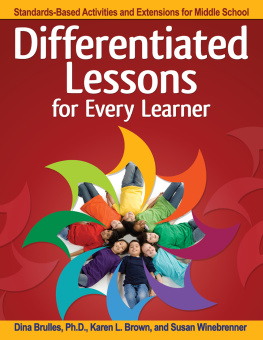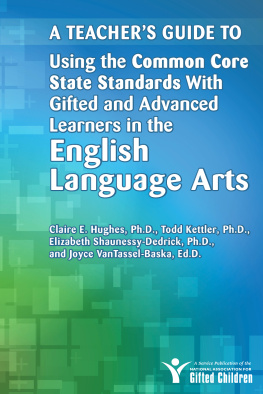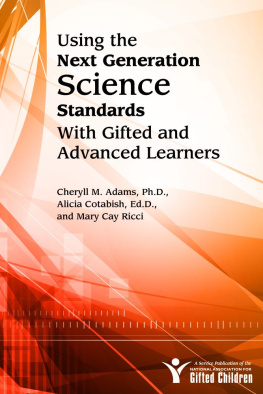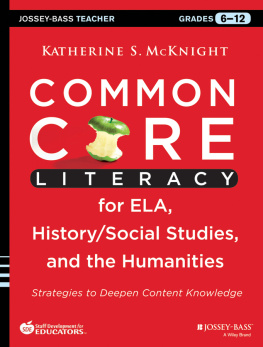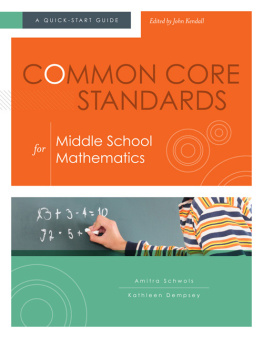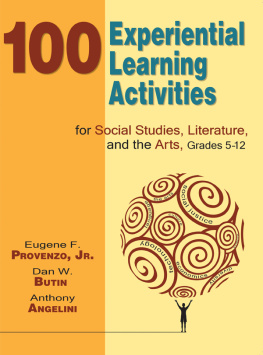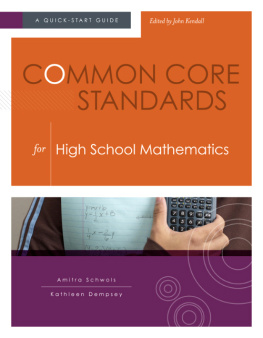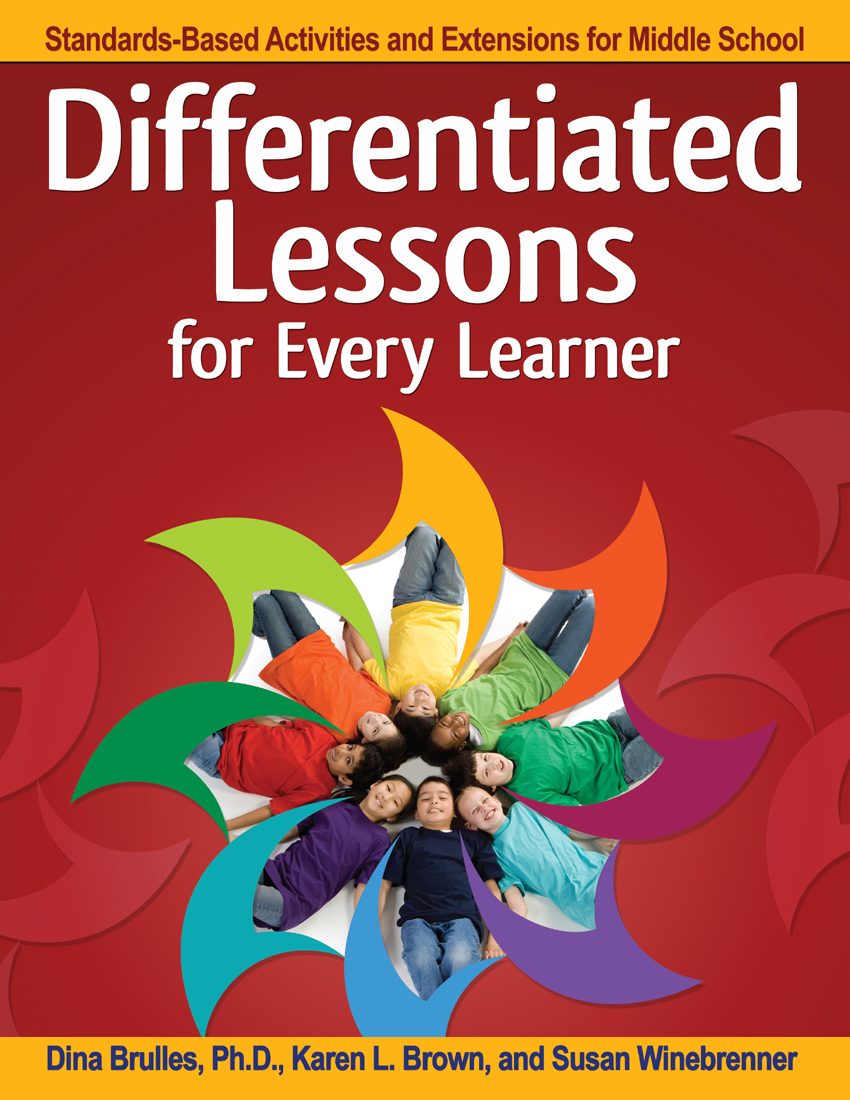

Standards-Based Activities and Extensions for Middle School
Differentiated
Lessons
for Every Learner
Dina Brulles, Ph.D.,
Karen L. Brown,
and Susan Winebrenner

Library of Congress Cataloging-in-Publication Data
Names: Brulles, Dina, author. | Brown, Karen L., 1960- author. | Winebrenner,
Susan, 1939- author.
Title: Differentiated lessons for every learner : standards-based activities
and extensions for middle school / by Dina Brulles, Karen L. Brown, and
Susan Winebrenner.
Description: Waco, Texas : Prufrock Press Inc., [2016] | Includes
bibliographical references.
Identifiers: LCCN 2015049598| ISBN 9781618215420 (pbk.) | ISBN 9781618216113
(epub)
Subjects: LCSH: Middle school education--Activity programs. | Middle
schools--Curricula. | Individualized instruction.
Classification: LCC LB1623 .B745 2016 | DDC 373.236--dc23
LC record available at http://lccn.loc.gov/2015049598
Copyright 2016, Prufrock Press Inc.
Edited by Katy McDowall
Cover design by Raquel Trevino
ISBN-13: 978-1-61821-611-3
The purchase of this book entitles the buyer to reproduce student activity pages for single classroom use only. Other use requires written permission of publisher. All rights reserved.
At the time of this books publication, all facts and figures cited are the most current available. All telephone numbers, addresses, and website URLs are accurate and active. All publications, organizations, websites, and other resources exist as described in the book, and all have been verified. The author and Prufrock Press Inc. make no warranty or guarantee concerning the information and materials given out by organizations or content found at websites, and we are not responsible for any changes that occur after this books publication. If you find an error, please contact Prufrock Press Inc.

| Prufrock Press Inc.
P.O. Box 8813
Waco, TX 76714-8813
Phone: (800) 998-2208
Fax: (800) 240-0333
http://www.prufrock.com |
Table of Contents
Dedication
This book is dedicated to, and was inspired by, our amazing gifted teachers in Paradise Valley Unified School District and to the many teachers throughout the country who recognize the diverse ways in which students learn. Your students are fortunate to have you!
Acknowledgments
We would like to acknowledge and respect those of you who are seeking methods for ensuring all of our students are engaged in meaningful learning experiences. Your students deserve and appreciate your efforts.
Sincere gratitude goes out to all of the teachers who have contributed creative ideas for some of the lesson activities in this book. Special recognition goes to Becki West-Keur, whose brilliance and efforts influenced this work, especially in the special areas chapter. We are honored to have her teaching our gifted students in Paradise Valley. Lastly, we would like to thank our husbands, Dr. Mark Joraanstad, Daniel Brown, and Joe Ceccarelli, for their continued support of our work.
Foreword
When I began teaching in the early 1970s, I quickly became as bored with the learning activities in the curriculum as my students were. As a new teacher, it did not take me long to figure out that when I enriched the basic curriculum with extended thinking activities and provided opportunities for my students to choose from a list of assignments, they all became fully engaged in their learning. Even with my best efforts, however, it was difficult to create these opportunities with consistency across the school year. Several years later, I had the opportunity to take a course with Sandra Kaplan, Differentiating Curriculum for the Gifted Student. This course changed my approach to teaching forever. I now had a blueprint for differentiationchange the content, change the thinking processes, and/or change the products. I began to differentiate learning tasks for my middle school students by creating assignment menus in mathematics and language arts. This was not only an effective approach for gifted learners, but for all learners. And lets face it, gifted learnersthose who have been identified for G/T programs and those who have notall spend a good deal of time in the general education classroom.
I work now with teachers across the country to find more effective ways to get students to think deeply. The issue they struggle with most is finding the time and resources to develop and manage implementation of high-quality learning tasks that move students beyond canned answers to deeper thinking. Doing this within the required standards-based curriculum adds another layer of challenge for teachers. Deeper thinking takes time; students enter at different levels of readiness. Norman Webbs Framework of Depth of Knowledge (DOK) levels can fine-tune our understanding of how students process and engage with content and expand our concept of differentiation. Still, there have been few practical curricular resources that accurately interpret what DOK means and how to apply DOK levels across subject areas.
Finally there is a book that offers a plethora of high-quality options, closely aligned to the standards that teachers must teach. In Differentiated Lessons for Every Learner, Brulles, Brown, and Winebrenner prove that the marriage of DOK and differentiation for all students can result in using the required curriculum as a springboard for learning that is deeper and more meaningful for students. There is a lot to likeno, maybe loveabout this bookin both philosophy and practicality. It is a needed book. It fills a void. I think it will be an important book for general education, special education, and gifted education teachers alike.
First of all, the learning activities in this book are designed with the student in mind. Multiple optional activities, aligned with clusters of standards, naturally emerge from what all students are currently learning. This approach allows for flexible groupings based on entry points for different students and varied teaching methods. It also encourages student choice and students taking the initiative to plan and sustain individual and group projects. Because deeper thinking is at the heart of the examples, I can envision the roles of teachers and students shifting from teacher-directed to more student-directed learning over time. These are not just fun activities; they are designed to engage students.
Secondly, this approach is based in what we know about best practices for instruction, assessment, and deeper learning. Preassessment and formative assessment practices are encouraged with guidance as to how to determine a good match for each student or groupings of students. Learning activities are not simply about the verbs used in descriptions, but the complexity of content and thinking expected as evidence in the final products. Many examples allow for meaningful collaboration, which we know from research is good for deeper thinking and learning.
Next page
